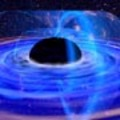Biggest 'small' black hole discovered
New Haven, Conn. — Discovery of the largest example of a “small” black hole — one formed from the collapse of a single massive star at the end of its lifetime — has led scientists to revaluate of how black holes come into being, according to a report in Nature.

“The theory we operated with for the last decade was that single-star black holes are formed from the remnants of massive stars — the more massive the star, the more massive the remnant. But, all of the stellar mass black holes were expected to be in the range of 10 times the mass of the sun or less, since only the core regions of the star would collapse,” said Charles Bailyn, the Thomas E. Donnelley Professor of Astronomy and Physics at Yale, and a member of the research team.
The research team, who identified the black hole with 15.65 times the mass of the sun, took advantage of “nature” to make an unusually precise measurement and required the surprised astronomers to reevaluate a long-standing theory.
Since black holes can't be seen — because they trap all matter and light that enters them — they are detected by the gravitational effects they have on nearby stars or other matter that is near them. This team made their calculations by measuring the motion of a star as it orbited abound the black hole, known as M33 X-7. The black hole completes one orbit every 3.45 days around its massive companion star.
“In this particular case, an eclipse in the system provided the exact orientation and gave mass information far more accurate than any previous reports,” said Bailyn. “Researchers rarely have such accurate points of reference.”
While some other papers have cited “small” black holes with masses of 12 to 14 times that of the sun, Bailyn said, “Those data had large margins of error that could still fit within the theory. Finding a black hole with such unusual characteristic points out that our understanding of the evolution of massive stars and the formation of black holes must be incomplete.”
This black hole is also the most distant stellar black hole ever observed and is located outside our galaxy — in a dwarf galaxy, Messier 33, that orbits Andromeda. Bailyn noted that, “Finding black holes in different and distant locations gives us many more objects to study and opens up the opportunity to find extreme examples that test theoretical limits.”
###
Lead author on the study is Jerome A. Orosz, associate professor in the Department of Astronomy at San Diego State University, and former graduate student who studied with Charles Bailyn at Yale. Other authors are Jeffrey McClintock, Ramesh Narayan, Joel Hartman, Jiefeng Liu, Lucas Macri, Wolfgang Pietsch, Ronald Remillard, Avi Shporer and Tseve Mazeh.
Scientists combined data from three observatories to make their discovery —NASA’s Chandra X-ray Observatory in orbit around the Earth, the Gemini North 8-meter telescope on the island of Hawai’i, and the 2.1-meter and WIYN 3.5-meter telescopes at Kitt Peak National Observatory near Tucson were combined to make the discovery. Support for the study came from the National Science Foundation.
For more information on black holes, see Charles Bailyn’s “Black Hole Toolbox”: http://cmi2.yale.edu/bh and the Chandra Observatory press release: http://chandra.harvard.edu/press/07_releases/press_101707.html